Rabbit Bed: Understanding Different Types of Beds and Their Benefits
Explore the various types of rabbit beds and their unique benefits. Choose the right rabbit bed to ensure your bunny's comfort and wellbeing.

Key Takeaways:
- Variety of Choices: From soft towels to sturdy wood frames, there’s a rabbit bed to suit every bunny’s preference and size, ensuring comfort and safety.
- Health Benefits: Proper rabbit beds can significantly enhance your bunny’s well-being by providing warmth, security, and support for their delicate bodies.
- Cost-Effective Solutions: Learn how to create a cozy sleeping area for your rabbit without breaking the bank, using simple materials like cardboard boxes and old towels.
- Essential Considerations: Remember to consider important things like the size, material, and placement of the bed to ensure your rabbit's comfort and safety.
Rabbits, with their soft fur and gentle hops, are not just pets but companions that bring joy and warmth to a home. Ensuring they have a comfortable place to rest is crucial for their health and happiness. This article explores the various types of rabbit beds available and their benefits, helping you make the best choice for your furry friend.

Introduction to Rabbit Care
As a responsible rabbit owner, creating a comfortable and safe environment for your bunny is one of the most important things you can do. The House Rabbit Society recommends setting up a cozy sleeping area for your rabbit, which can be as simple as a nice bed made from a cardboard box or an old towel. Since rabbits spend around eight hours a day sleeping, providing a soft and comfortable bed is crucial for their well-being.
You have plenty of options when it comes to making your bun’s bed. Some rabbits love to snuggle into soft blankets or towels, while others might prefer the sturdy feel of a wooden frame. Whether you choose wood, plush blankets, or layers of towels, the key is to make sure the bed is both cute and comfortable for your rabbit. A soft, inviting bed not only helps your bunny sleep better but also gives them a safe place to relax and feel secure.
When introducing a new bed to your rabbit, be careful and give them time to adjust. Some buns may be curious right away, while others might need a bit longer to warm up to their new sleeping spot. Watch your rabbit’s behavior and make changes as needed to ensure they feel comfortable and safe in their new bed. With a little patience and attention, you’ll soon find the perfect setup that your bun loves.
Understanding Rabbit Beds
What is a Rabbit Bed?
A rabbit bed provides a dedicated space for your bunny to rest, sleep, and feel secure. Unlike other pets, rabbits have specific needs due to their size and behavior patterns. The right bed can help prevent injuries and provide a safe haven where your rabbit can retreat.
Importance of Choosing the Right Bed
Selecting the appropriate bed is vital for your rabbit’s comfort and safety. A good bed supports their delicate spine and keeps them warm during colder periods. It also offers a refuge from the stress of the outside world or busier parts of the house.
Always check that the materials used in the bed are safe for rabbits, as some fabrics can be harmful if ingested.
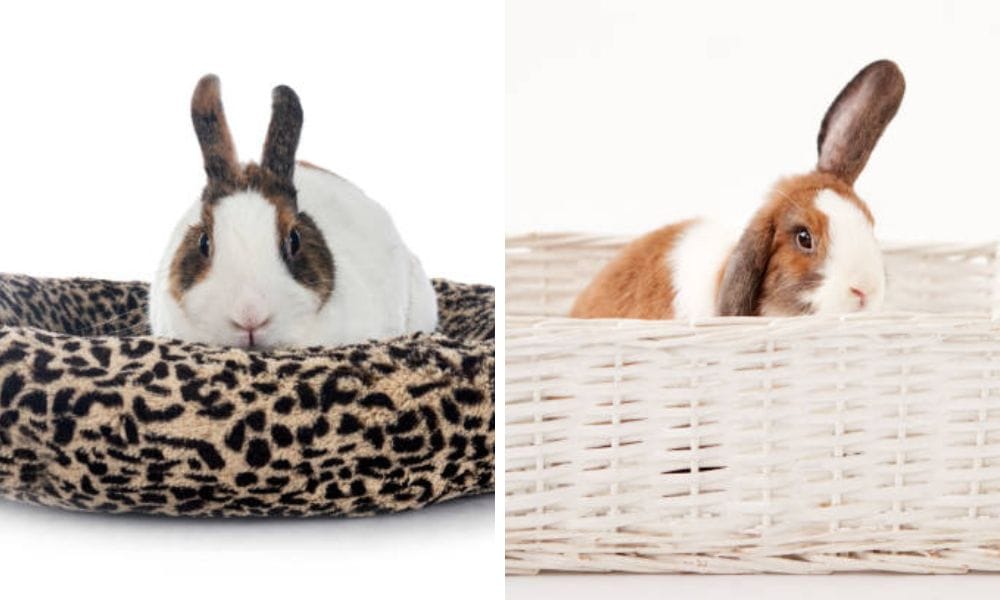
Types of Rabbit Beds
Soft Beds
Soft beds, often made from fabrics like fleece or cotton, are perfect for bunnies who love to burrow and stay warm. Many soft beds feature a removable cover that is easy to wash, making maintenance simple and keeping the bed fresh for your rabbit. These beds are usually padded and come in various shapes and sizes, typically ranging from 12 to 24 inches, to accommodate any rabbit breed, from the tiny mini lop to the larger breeds.
Wood Frame Beds
For those who prefer something more durable, wood frame beds are an excellent choice. They provide a sturdy base and are less likely to be chewed up by a teething bunny. However, it’s crucial to ensure the wood is untreated and safe for rabbits to nibble on occasionally.
These wood frame beds can also serve as stylish rabbit furniture, blending seamlessly with your home decor while providing a functional resting place for your pet.
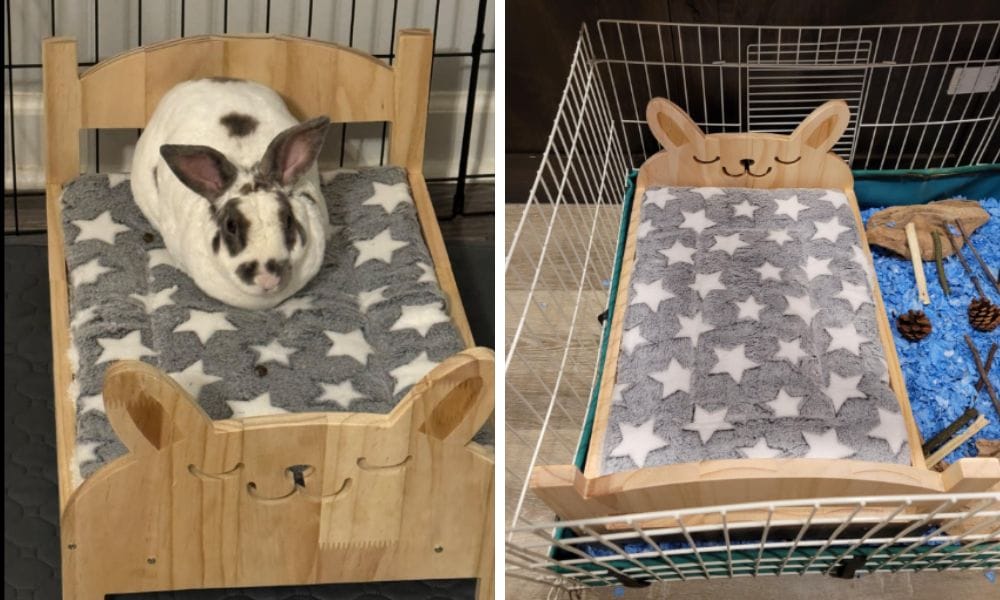
DIY Rabbit Bed Ideas
Using Cardboard Boxes
A simple and cost-effective option is to transform a cardboard box into a cozy bed. By lining it with soft blankets or towels, you can create a comfortable and secure sleeping area. This is not only easy on the wallet but also a great way to recycle.
Feel free to share your own creative DIY rabbit bed ideas in the comments below!
Towel Beds
Old towels can be fashioned into a snug bed by folding them into a soft pile or wrapping them around a warm fabric. This method allows for easy cleaning and replacement, ensuring that your rabbit's sleeping space is always fresh and inviting.
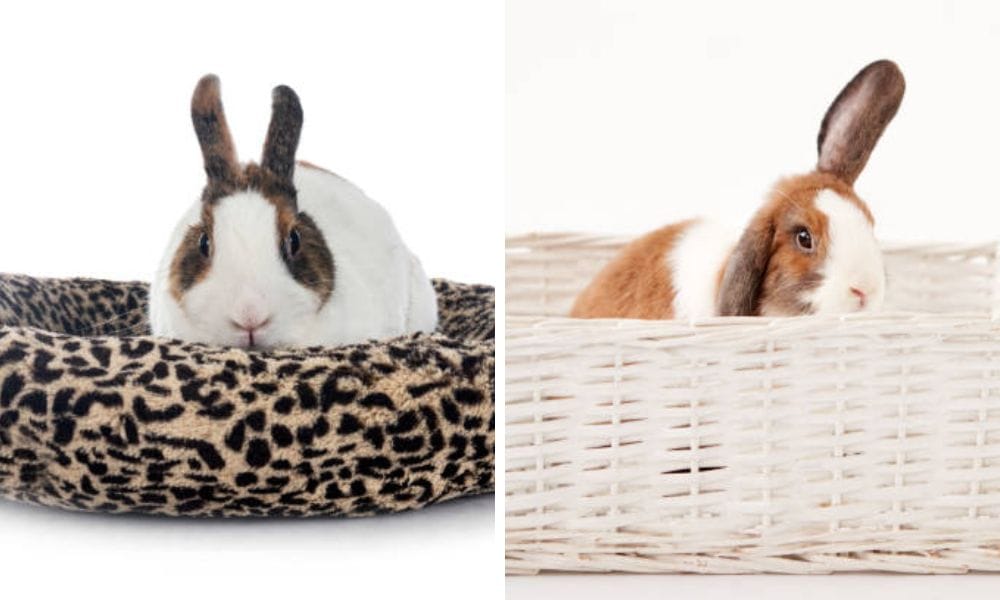
Benefits of Rabbit Beds
Innovative Rabbit Bed Designs
When considering the design of a rabbit bed, creativity can go a long way in ensuring your bunny’s comfort and safety. One popular trend is the integration of bed frames made from safe, chew-resistant materials like hard plastic or untreated wood. These frames can elevate the sleeping box slightly off the ground, which helps to keep the bed clean and dry. Additionally, some pet owners have started incorporating a small hop-in entrance, which not only adds a cute factor but also makes it easier for smaller or older bunnies to access their sleeping quarters without having to jump.
Some innovative rabbit beds are sold as a set, including matching pillows and covers for added convenience and a coordinated look.
Another exciting design involves using old shirts or soft towels to create a snug, nest-like environment within the bed frame. This can be particularly comforting for rabbits, as the scent of their owner on the fabric can make them feel more secure and protected. To enhance this design, some owners add layers of soft blankets or hay, which can be easily removed and cleaned. It's also simple to switch out covers or cushions to keep the bed fresh or to update the look for different seasons. This type of bed is perfect for bunnies that love to burrow and hide, providing them with a warm and private retreat.
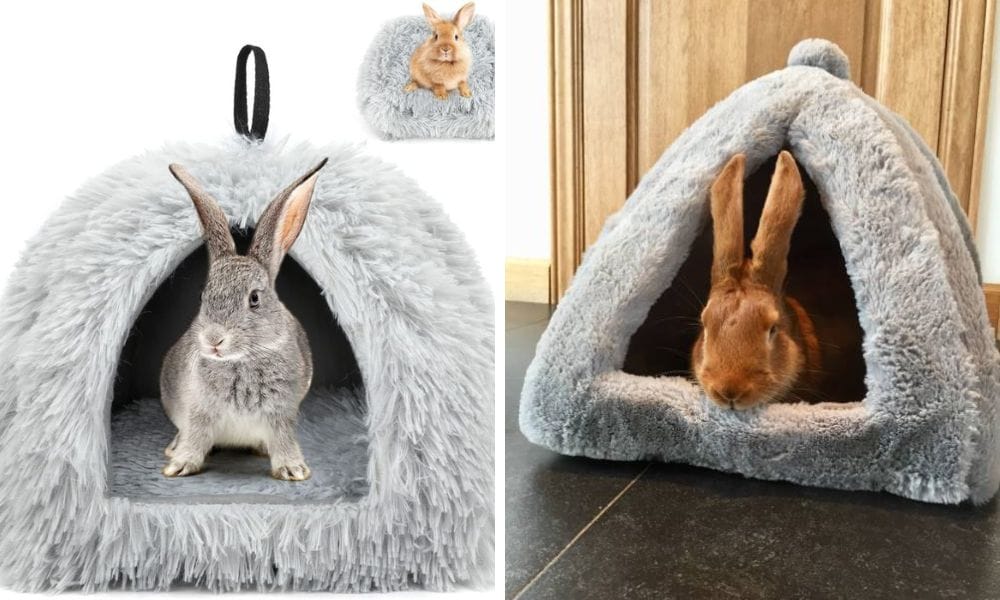
Environmental Impact of Rabbit Beds
When considering the environmental impact of rabbit beds, it's essential to choose materials that are both sustainable and safe for your pet. Many rabbit owners are turning to eco-friendly options like beds made from recycled paper or organic cotton, which not only provide comfort but also ensure that your bunny's sleeping habits don't harm the planet. By opting for materials that are biodegradable and sourced through ethical practices, you can make a positive impact on the environment while keeping your rabbit cozy and comfortable.
Moreover, the production process of rabbit beds can also contribute to their environmental footprint. Beds made from synthetic materials may involve processes that release harmful chemicals, which are not only bad for the earth but can also pose health risks to your rabbit. Choosing rabbit beds made from natural fibers like hemp or bamboo can significantly reduce these risks. These materials are not only durable and comfortable but also require less water and pesticides to produce, making them an excellent choice for environmentally conscious rabbit owners.
Creative and Fun Rabbit Bed Designs
In the world of rabbit beds, creativity knows no bounds. Many pet owners enjoy crafting unique sleeping solutions that not only serve as a comfortable resting place for their bunnies but also add a touch of whimsy to their home decor. A well-designed rabbit bed can be a pretty addition to your home, enhancing both comfort and aesthetics. For instance, a bed frame made from repurposed wood can be shaped into a mini house, giving your rabbit a private and secure place to sleep. Adding soft blankets or an old towel to the interior can make it even more inviting and warm for your pet.
Another fun idea is to transform a simple cardboard box into a themed sleeping box. With a bit of non-toxic paint and some cut-outs, you can turn a mundane box into a castle, spaceship, or whatever sparks your bunny’s interest. This not only provides a safe and snug area for your rabbit to rest but also stimulates their mind and satisfies their curiosity. These creative beds not only offer a cozy place to sleep but also encourage play and exploration, making them a fun and enriching environment for your bunny. These creative beds can be a great way to bond with your pet, as you can continually modify and adapt the designs to keep your bunny engaged and happy.
Cost-Effective Solutions for Rabbit Beds
For bunny owners on a budget, there are several cost-effective solutions that do not compromise on comfort or quality. One popular option is to repurpose cardboard boxes into cozy beds. By lining a sturdy cardboard box with a soft towel or fleece, you can create a comfortable and warm bed for your rabbit. This solution not only saves money but also recycles materials that might otherwise be discarded. Additionally, these makeshift beds are easy to replace once they become worn out or chewed up, ensuring that your bunny always has a clean place to rest. With proper care, some DIY beds can continue to provide comfort for your rabbit over time, especially if you refresh or replace the lining as needed.
Another economical approach is to look for discounts or promotions on rabbit beds from pet stores or online retailers. Often, you can find durable and attractive beds at a fraction of the cost during sales events. For those who are handy, DIY projects can also be a fun and rewarding way to provide for your pet. Simple bed designs can be crafted from scrap fabrics and materials you already have at home, allowing you to customize the size, shape, and pattern to perfectly suit your rabbit’s preferences and your home’s decor.

Comfort and Security
A well-chosen rabbit bed provides a sense of security and comfort to your pet. Rabbits are prey animals by nature, and having a snug hideaway can significantly reduce stress and anxiety. Most rabbits will sleep on blankets, couches, mats, or bare floors as long as they feel safe and protected.
Health Advantages
Sleeping on a hard, cold floor can lead to health issues like sore hocks or colds. A rabbit bed helps to keep your bunny warm and supports their joints, which is particularly beneficial for older rabbits.
During spring, rabbits can shed like crazy, so it's important to keep their bed clean to prevent skin problems.
Choosing the Right Size and Material
Size Matters
It's essential to choose a bed that matches your rabbit's size. A bed that's too small can be uncomfortable, while one that's too large may not provide the feeling of security they crave.
Material Considerations
The material of the rabbit bed should be durable yet comfortable. Avoid materials that can easily be torn apart or are hard to clean. Fabrics that retain heat are preferable, especially in colder climates.

Safety Considerations for Rabbit Beds
When it comes to choosing the perfect bunny bed, safety should always come first. The House Rabbit Society recommends selecting a nice bed made from non-toxic, durable materials that are safe for your rabbit to chew on. Whether you opt for a soft fabric bed, a sturdy wood frame, or a simple cardboard box, make sure the materials are free from harmful chemicals and small parts that could pose a choking hazard.
A safe bunny bed should be the right size for your rabbit—big enough for them to stretch out comfortably, but cozy enough to make them feel secure. Avoid beds with loose threads or exposed staples, as curious buns love to nibble and could accidentally ingest something dangerous. If you’re using wood, ensure it’s untreated and safe for rabbits, and if you choose fabric, pick something soft and washable to keep your bunny’s sleeping area clean and comfortable. Some people have raised concerns about the safety of certain bedding materials, such as fleece, so it's important to choose options that are proven safe for rabbits.
Placement is also key to safety. Put your rabbit’s bed in a quiet, draft-free place, away from windows, doors, or heating vents. Keep the bed close to your bunny’s favorite spot, but not too close to electrical outlets or cords. By paying attention to these details, you’ll create a comfortable and safe sleeping environment where your rabbit can relax and rest easy.
Creating a Cozy Environment for Your Rabbit
A cozy environment is just as important as the bed itself when it comes to helping your rabbit feel at home. Start by providing a soft bunny bed or a warm cardboard box lined with plush blankets or towels—these simple touches can make a world of difference in your bunny’s comfort. Rabbits love to snuggle into soft materials, so layering their bed with fleece or a favorite old towel can help them feel safe and secure as they sleep.
Think about the room where your rabbit spends most of their time. Make sure it’s warm, dry, and free from drafts, as rabbits are sensitive to temperature changes. A cute crate, cage, or enclosed area can give your bunny a sense of security, especially if you add cozy accessories like a fleece tunnel or a plastic log for them to hop through and explore. These little extras not only make the space more inviting but also keep your rabbit entertained and happy.
Don’t forget to check the enclosure regularly to ensure it stays clean and comfortable. By creating a soft, safe place for your rabbit to rest—whether it’s a simple box or a fancy bunny bed—you’ll help your bun feel relaxed, content, and truly at home.
We’d love to see how you’ve set up your rabbit’s space! Share a photo of your bunny’s cozy bed setup in the comments or on social media.
Maintenance Tips for Rabbit Beds
Cleaning and Care
Regular cleaning is crucial to prevent the buildup of bacteria and odors. Most fabric beds are machine washable, which makes them convenient to maintain. For wood frames, a simple wipe-down with a damp cloth can do the trick.
Replacement and Upkeep
Over time, any rabbit bed will show signs of wear and tear. It's important to inspect the bed regularly for any damage that could harm your rabbit, such as loose threads or exposed nails.
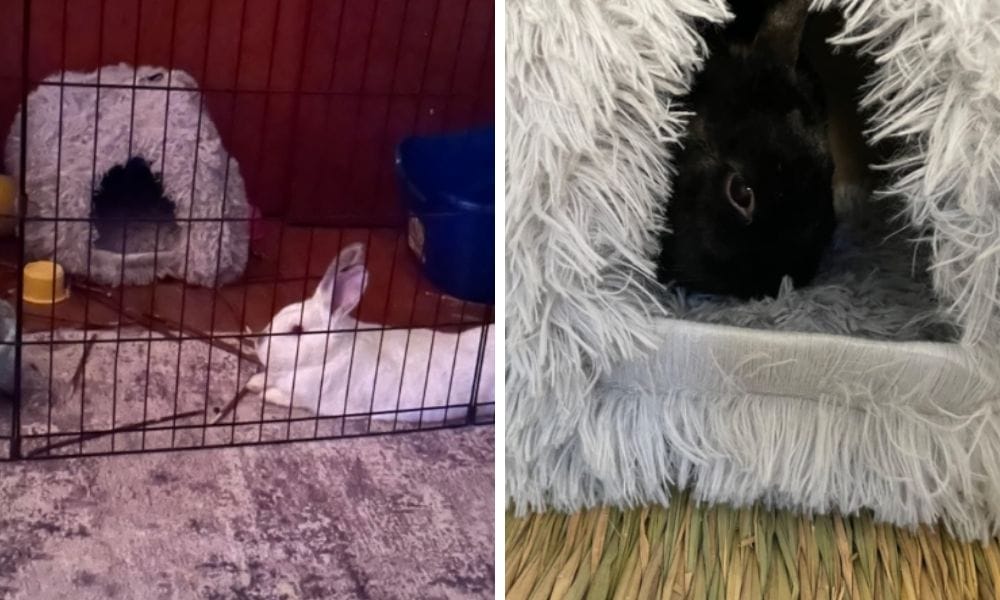
Tips for Rabbit Owners
Keeping your bunny happy and healthy starts with providing a comfortable and safe environment, and that includes a nice bed and plenty of cozy hiding spots. When choosing a bed, consider your rabbit’s unique preferences—some buns love to burrow into soft fleece or cotton, while others might stretch out on a cool wood or plastic surface. The most important thing is that your rabbit feels comfortable and secure while they sleep.
Be careful when introducing new materials or toys to your rabbit’s space, as curious buns love to chew and might have accidents with unfamiliar items. Always check that any bed, whether it’s made from wood, soft fabric, or plastic, is free from loose threads or sharp edges that could cause harm. Regularly clean your rabbit’s cage and replace bedding materials like wood shavings or hay to keep their sleeping area dry and fresh.
It’s a good idea to check your rabbit’s bed often for signs of wear or damage. If you notice holes, frayed edges, or any part that looks unsafe, replace the bed right away to keep your bunny comfortable and safe. By paying attention to your rabbit’s needs and making small changes as needed, you’ll create a cozy, inviting space that your bun will love to call home.
Common Mistakes to Avoid
Identifying and Preventing Common Errors
When it comes to providing a comfortable and safe sleeping space for your furry friend, there are several common mistakes to avoid. Here are some of the most frequent errors to watch out for:
- Insufficient Size: One of the most common mistakes is choosing a bed that’s too small. Your bunny needs enough space to stretch out comfortably. A cramped bed can lead to discomfort and stress, which is the last thing you want for your beloved pet.
- Poor Material Choice: Not all materials are safe for rabbits. Avoid beds made from toxic or hazardous materials. Instead, opt for natural, non-toxic options like untreated wood or cotton. These materials are not only safe but also durable and comfortable for your bunny.
- Inadequate Ventilation: Proper ventilation is crucial to prevent moisture buildup, which can lead to mold and mildew. Ensure the bed design allows for adequate airflow to keep your rabbit cool and dry, especially in warmer climates.
- Incorrect Placement: The location of the bed is just as important as the bed itself. Place the bed in a safe, comfortable spot away from drafts, direct sunlight, and extreme temperatures. This helps create a cozy and secure environment for your bunny.
- Failure to Clean: Regular cleaning is essential to maintain a healthy sleeping space. Neglecting to clean the bed can lead to the buildup of bacteria and odors, which can be harmful to your rabbit’s health. Make it a habit to clean and inspect the bed frequently.
By avoiding these common mistakes, you can ensure that your rabbit’s bed is a safe, comfortable, and inviting place for them to rest. Taking these precautions will help promote your bunny’s overall health and well-being, making their home a true haven.
Summary
Choosing the right rabbit bed is essential for your bunny's comfort and overall health. Whether you opt for a store-bought bed or decide to craft one yourself, ensuring it is safe, comfortable, and appropriately sized will make a significant difference in your rabbit's quality of life. From soft fabric beds to more robust wood frames, there's a variety of options to suit every bunny's needs.
FAQ
What is the best material for a rabbit bed?
The best materials for a rabbit bed are soft, warm, and easy to clean, such as fleece or cotton. Ensure the material is durable and safe for rabbits to chew on occasionally.
How often should I replace my rabbit's bed?
You should replace your rabbit's bed whenever it shows signs of wear, such as holes or significant fading. Regular inspections will help you determine the right time for a replacement.
Can rabbits sleep in beds with elevated frames?
Yes, rabbits can sleep in elevated beds, but it's important to ensure the bed is stable and the height is not too great, as rabbits can be injured if they fall.

